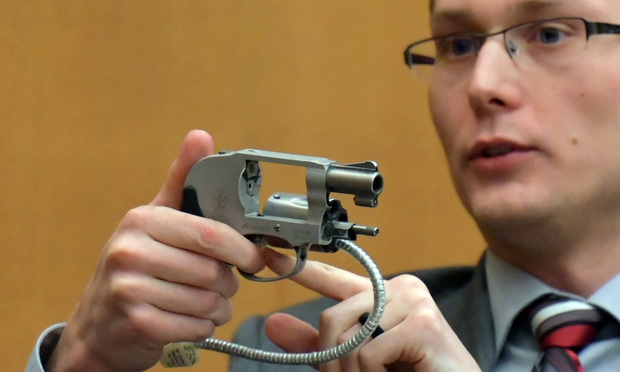Gun Expert Says Trigger Needed to Be Pulled for Shot That Killed Diane McIver
Atlanta attorney Tex McIver and his lawyers have always said the gun he was holding fired accidentally when his wife was shot.
March 29, 2018 at 04:24 PM
6 minute read

A firearms expert with the Georgia Bureau of Investigation testified Thursday that the Smith & Wesson .38 revolver Atlanta attorney Claud “Tex” McIver was holding when he fatally shot his wife would not have fired if it was simply resting on his lap.
Zachary Weitzel, a technical director in the GBI's firearms division, said the gun would not discharge if someone was simply holding it.
“Something would have to act on the trigger,” he said. “The trigger has to be pulled rearward.”
That testimony is at odds with multiple explanations offered by McIver, who is on trial on charges that he murdered his wife and then influenced witnesses after he shot her on Sept. 25, 2016.
McIver, his attorneys, and his spokesmen have always said Diane McIver's shooting was an accident. Prosecutors claim the former Fisher & Phillips partner had a financial motivation.
McIver has claimed he had the gun on his lap and that he may have fallen asleep as a family friend drove the couple home when it suddenly fired as their Ford Expedition was stopped at a traffic light. McIver and his spokesmen also claimed immediately after the shooting that the gun fired when the vehicle hit a bump, although that story later changed.
Weitzel also said the gun was not malfunctioning and that it had two safety features that would hamper accidental firings.
Rucker asked Weitzel whether a gun held by an individual in a vehicle would fire if it hit a bump if the person did not depress the trigger.
“The movement of the gun should not fire the gun,” Weitzel aid. “It has to be a force acting on the trigger.”
But McIver defense lawyer Bruce Harvey asked if Weitzel knew if the gun could be unintentionally as opposed to accidentally discharged, a distinction he explained as putting pressure on a gun trigger unintentionally “for a number of reasons including being startled … It is a very common occurrence, especially with police officers,” he added.
“The presence of double-action and the design of the gun is supposed to act as a safeguard against that,” Weitzel explained. “This is a double-action/single-action gun.”
Weitzel also testified that the revolver required nearly 12 pounds of pressure in order to cock the gun and fire it. If the gun was already cocked, it would still require nearly 2 pounds of pressure.
The revolver also had a feature known as a “shroud” that contained the hammer, Weitzel testified. That feature was intended to prevent the hammer from being snagged on clothing or some other obstacle when it was drawn that might cause the gun to inadvertently fire. The shroud, he said, also protects the hammer if the gun is dropped.
Weitzel also said the gun was loaded with two kinds of ammunition—three full metal jacketed bullets that often pass through a target, and two hollow point bullets that expand on impact. The spent cartridge and the bullet that was recovered from the front passenger seat of the SUV where Diane McIver was sitting had a full metal jacket, he said.
Jurors on Thursday wanted to know if the manner in which the gun's safety features functioned changed if the gun was cocked—known as single-action mode—or not, known as double-action mode.
Weitzel said the gun's safety features are designed to function in tandem with the trigger. When the trigger is pulled, the safety features are not in play, he said.
When the gun is in single-action mode with the hammer cocked, he said, “It's primed; it's ready to be fired. The only way the gun will fire is if the trigger is pulled and held long enough for the hammer to fall and the gun to fire.”
At one point, as Weitzel demonstrated to jurors the force on the trigger required to cock it and fire the gun his hand began shaking. Over Harvey's objections, Rucker asked why his hand was shaking.
Weitzel replied that because the gun was operating in double-action mode, “It's relatively heavy poundage” to actually fire the gun. “It's normal for the double-action on a revolver,” he said.
Prosecutors continued to build their criminal case against McIver with testimony from crime scene reconstruction expert Michael Knox, who said McIver's explanation of how he was holding the gun when it fired was inconsistent with the bullet's trajectory through the front passenger seat.
Knox also testified that a photo of defense attorney Amanda Clark Palmer—who earlier in the trial mimicked what she said was McIver's position in the car by lolling backward in a seat with her hands in her lap—was inconsistent with the bullet's trajectory.
In an interview with Atlanta homicide detectives three days after his wife died, McIver showed them he was holding the gun in his lap with the muzzle angled downward when it fired.
Knox said the bullet did not travel into the seat at a 90 degree angle. Instead it was about 15 degrees off and moving right to left. It was also angled upward about 2.4 degrees, he said.
As a result, when positioned along that trajectory, the gun could have been alongside or resting on McIver's right hip adjacent to the rear passenger door when it fired, Knox said. But if it were closer to the center of his lap, the gun muzzle—and McIver's hands—must have been raised, he said.
“It's possible the gun could have rested on the [right] hip and be in a sideways position,” Knox testified. “As the gun moves forward and closer to the seat, any position would have to be elevated off the lap.”
Harvey challenged Knox, suggesting he didn't know how the gun was positioned.
“It can be upside down. It can be sideways. It can be in any particular position as long as the muzzle, the barrel is in line with the known trajectory,” he said. “At the end of the day, you can't say where it was.”
This content has been archived. It is available through our partners, LexisNexis® and Bloomberg Law.
To view this content, please continue to their sites.
Not a Lexis Subscriber?
Subscribe Now
Not a Bloomberg Law Subscriber?
Subscribe Now
NOT FOR REPRINT
© 2025 ALM Global, LLC, All Rights Reserved. Request academic re-use from www.copyright.com. All other uses, submit a request to [email protected]. For more information visit Asset & Logo Licensing.
You Might Like
View All
Sunbelt Law Firms Experienced More Moderate Growth Last Year, Alongside Some Job Cuts and Less Merger Interest
4 minute read
Fowler White Burnett Opens Jacksonville Office Focused on Transportation Practice
3 minute read
Georgia High Court Clarifies Time Limit for Lawyers' Breach-of-Contract Claims
6 minute read
Southeast Firm Leaders Predict Stability, Growth in Second Trump Administration
4 minute readTrending Stories
- 1Uber Files RICO Suit Against Plaintiff-Side Firms Alleging Fraudulent Injury Claims
- 2The Law Firm Disrupted: Scrutinizing the Elephant More Than the Mouse
- 3Inherent Diminished Value Damages Unavailable to 3rd-Party Claimants, Court Says
- 4Pa. Defense Firm Sued by Client Over Ex-Eagles Player's $43.5M Med Mal Win
- 5Losses Mount at Morris Manning, but Departing Ex-Chair Stays Bullish About His Old Firm's Future
Who Got The Work
J. Brugh Lower of Gibbons has entered an appearance for industrial equipment supplier Devco Corporation in a pending trademark infringement lawsuit. The suit, accusing the defendant of selling knock-off Graco products, was filed Dec. 18 in New Jersey District Court by Rivkin Radler on behalf of Graco Inc. and Graco Minnesota. The case, assigned to U.S. District Judge Zahid N. Quraishi, is 3:24-cv-11294, Graco Inc. et al v. Devco Corporation.
Who Got The Work
Rebecca Maller-Stein and Kent A. Yalowitz of Arnold & Porter Kaye Scholer have entered their appearances for Hanaco Venture Capital and its executives, Lior Prosor and David Frankel, in a pending securities lawsuit. The action, filed on Dec. 24 in New York Southern District Court by Zell, Aron & Co. on behalf of Goldeneye Advisors, accuses the defendants of negligently and fraudulently managing the plaintiff's $1 million investment. The case, assigned to U.S. District Judge Vernon S. Broderick, is 1:24-cv-09918, Goldeneye Advisors, LLC v. Hanaco Venture Capital, Ltd. et al.
Who Got The Work
Attorneys from A&O Shearman has stepped in as defense counsel for Toronto-Dominion Bank and other defendants in a pending securities class action. The suit, filed Dec. 11 in New York Southern District Court by Bleichmar Fonti & Auld, accuses the defendants of concealing the bank's 'pervasive' deficiencies in regards to its compliance with the Bank Secrecy Act and the quality of its anti-money laundering controls. The case, assigned to U.S. District Judge Arun Subramanian, is 1:24-cv-09445, Gonzalez v. The Toronto-Dominion Bank et al.
Who Got The Work
Crown Castle International, a Pennsylvania company providing shared communications infrastructure, has turned to Luke D. Wolf of Gordon Rees Scully Mansukhani to fend off a pending breach-of-contract lawsuit. The court action, filed Nov. 25 in Michigan Eastern District Court by Hooper Hathaway PC on behalf of The Town Residences LLC, accuses Crown Castle of failing to transfer approximately $30,000 in utility payments from T-Mobile in breach of a roof-top lease and assignment agreement. The case, assigned to U.S. District Judge Susan K. Declercq, is 2:24-cv-13131, The Town Residences LLC v. T-Mobile US, Inc. et al.
Who Got The Work
Wilfred P. Coronato and Daniel M. Schwartz of McCarter & English have stepped in as defense counsel to Electrolux Home Products Inc. in a pending product liability lawsuit. The court action, filed Nov. 26 in New York Eastern District Court by Poulos Lopiccolo PC and Nagel Rice LLP on behalf of David Stern, alleges that the defendant's refrigerators’ drawers and shelving repeatedly break and fall apart within months after purchase. The case, assigned to U.S. District Judge Joan M. Azrack, is 2:24-cv-08204, Stern v. Electrolux Home Products, Inc.
Featured Firms
Law Offices of Gary Martin Hays & Associates, P.C.
(470) 294-1674
Law Offices of Mark E. Salomone
(857) 444-6468
Smith & Hassler
(713) 739-1250






